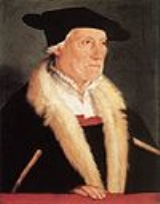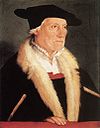
Sebastian Münster
Encyclopedia
Sebastian Münster was a German
cartographer, cosmographer, and a Hebrew
scholar.

, the son of Andreas Munster. He completed his studies at the Eberhard-Karls-Universität Tübingen in 1518. His graduate adviser was Johannes Stöffler.
He was appointed to the University of Basel
in 1527. As Professor of Hebrew, he edited the Hebrew Bible
, accompanied by a Latin
translation.
His work, the Cosmographia
from 1544 was the earliest German description of the world. It had numerous editions in different languages including Latin
, French
, Italian
, English
, and even Czech
. The last German edition was published in 1628, long after his death. The Cosmographia was one of the most successful and popular books of the 16th century. It passed through 24 editions in 100 years. This success was due to the fascinating woodcut
s (some by Hans Holbein the Younger
, Urs Graf
, Hans Rudolph Manuel Deutsch, and David Kandel
). It was most important in reviving geography in 16th century Europe.
In 1540 he published a Latin edition of Ptolemy
's Geographia with illustrations. The 1550 edition contains cities, portraits, and costumes. These editions, printed in Germany, are the most valued of the Cosmographias.
Münster also wrote the Dictionarium trilingue in Latin, Greek, and Hebrew and Mappa Europae (map of Europe) in 1536. In 1537 he published a Hebrew Gospel of Matthew
which he had obtained from Spanish Jews he had converted.
He died at Basel
of the plague
in 1552.
He was pictured on the old 100 DM banknotes that were replaced at the beginning of the 1990s.
 Several paintings with oil on canvas, woodcuts and copper etchings depict Sebastian Münster, by Hans Holbein d. J. (Basel, c. 1530), Willem de Haen (1615), as rector of the University of Basel
Several paintings with oil on canvas, woodcuts and copper etchings depict Sebastian Münster, by Hans Holbein d. J. (Basel, c. 1530), Willem de Haen (1615), as rector of the University of Basel
(by Christoph Amberger
, um 1547), and on the 100-DM-bill as used 1962 to 1991.
Germany
Germany , officially the Federal Republic of Germany , is a federal parliamentary republic in Europe. The country consists of 16 states while the capital and largest city is Berlin. Germany covers an area of 357,021 km2 and has a largely temperate seasonal climate...
cartographer, cosmographer, and a Hebrew
Hebrew language
Hebrew is a Semitic language of the Afroasiatic language family. Culturally, is it considered by Jews and other religious groups as the language of the Jewish people, though other Jewish languages had originated among diaspora Jews, and the Hebrew language is also used by non-Jewish groups, such...
scholar.

Life
Münster was born at Ingelheim near MainzMainz
Mainz under the Holy Roman Empire, and previously was a Roman fort city which commanded the west bank of the Rhine and formed part of the northernmost frontier of the Roman Empire...
, the son of Andreas Munster. He completed his studies at the Eberhard-Karls-Universität Tübingen in 1518. His graduate adviser was Johannes Stöffler.
He was appointed to the University of Basel
University of Basel
The University of Basel is located in Basel, Switzerland, and is considered to be one of leading universities in the country...
in 1527. As Professor of Hebrew, he edited the Hebrew Bible
Hebrew Bible
The Hebrew Bible is a term used by biblical scholars outside of Judaism to refer to the Tanakh , a canonical collection of Jewish texts, and the common textual antecedent of the several canonical editions of the Christian Old Testament...
, accompanied by a Latin
Latin
Latin is an Italic language originally spoken in Latium and Ancient Rome. It, along with most European languages, is a descendant of the ancient Proto-Indo-European language. Although it is considered a dead language, a number of scholars and members of the Christian clergy speak it fluently, and...
translation.
His work, the Cosmographia
Cosmographia (Sebastian Münster)
The Cosmographia by Sebastian Münster from 1544 is the earliest German description of the world. It had numerous editions in different languages including Latin, French , Italian, English, and even Czech. The last German edition was published in 1628, long after his death...
from 1544 was the earliest German description of the world. It had numerous editions in different languages including Latin
Latin
Latin is an Italic language originally spoken in Latium and Ancient Rome. It, along with most European languages, is a descendant of the ancient Proto-Indo-European language. Although it is considered a dead language, a number of scholars and members of the Christian clergy speak it fluently, and...
, French
French language
French is a Romance language spoken as a first language in France, the Romandy region in Switzerland, Wallonia and Brussels in Belgium, Monaco, the regions of Quebec and Acadia in Canada, and by various communities elsewhere. Second-language speakers of French are distributed throughout many parts...
, Italian
Italian language
Italian is a Romance language spoken mainly in Europe: Italy, Switzerland, San Marino, Vatican City, by minorities in Malta, Monaco, Croatia, Slovenia, France, Libya, Eritrea, and Somalia, and by immigrant communities in the Americas and Australia...
, English
English language
English is a West Germanic language that arose in the Anglo-Saxon kingdoms of England and spread into what was to become south-east Scotland under the influence of the Anglian medieval kingdom of Northumbria...
, and even Czech
Czech language
Czech is a West Slavic language with about 12 million native speakers; it is the majority language in the Czech Republic and spoken by Czechs worldwide. The language was known as Bohemian in English until the late 19th century...
. The last German edition was published in 1628, long after his death. The Cosmographia was one of the most successful and popular books of the 16th century. It passed through 24 editions in 100 years. This success was due to the fascinating woodcut
Woodcut
Woodcut—occasionally known as xylography—is a relief printing artistic technique in printmaking in which an image is carved into the surface of a block of wood, with the printing parts remaining level with the surface while the non-printing parts are removed, typically with gouges...
s (some by Hans Holbein the Younger
Hans Holbein the Younger
Hans Holbein the Younger was a German artist and printmaker who worked in a Northern Renaissance style. He is best known as one of the greatest portraitists of the 16th century. He also produced religious art, satire and Reformation propaganda, and made a significant contribution to the history...
, Urs Graf
Urs Graf
Urs Graf was a Swiss Renaissance painter and printmaker , as well as a mercenary soldier. He only produced two etchings, one of which dates from 1513 – the earliest known etching for which a date has been established...
, Hans Rudolph Manuel Deutsch, and David Kandel
David Kandel
David Kandel was a Renaissance artist.One of the best qualities of the Renaissance Period was its everlasting concern with the elements of the natural world. David Kandel was one of the best known pioneers of botanical art and science...
). It was most important in reviving geography in 16th century Europe.
In 1540 he published a Latin edition of Ptolemy
Ptolemy
Claudius Ptolemy , was a Roman citizen of Egypt who wrote in Greek. He was a mathematician, astronomer, geographer, astrologer, and poet of a single epigram in the Greek Anthology. He lived in Egypt under Roman rule, and is believed to have been born in the town of Ptolemais Hermiou in the...
's Geographia with illustrations. The 1550 edition contains cities, portraits, and costumes. These editions, printed in Germany, are the most valued of the Cosmographias.
Münster also wrote the Dictionarium trilingue in Latin, Greek, and Hebrew and Mappa Europae (map of Europe) in 1536. In 1537 he published a Hebrew Gospel of Matthew
Hebrew Gospel of Matthew
The Rabbinical translations of Matthew are rabbinical versions of the Gospel of Matthew that are written in Hebrew; Shem-Tob's Matthew, the Du Tillet Matthew, and the Münster Matthew, and which were used in polemical debate with Christians....
which he had obtained from Spanish Jews he had converted.
He died at Basel
Basel
Basel or Basle In the national languages of Switzerland the city is also known as Bâle , Basilea and Basilea is Switzerland's third most populous city with about 166,000 inhabitants. Located where the Swiss, French and German borders meet, Basel also has suburbs in France and Germany...
of the plague
Black Death
The Black Death was one of the most devastating pandemics in human history, peaking in Europe between 1348 and 1350. Of several competing theories, the dominant explanation for the Black Death is the plague theory, which attributes the outbreak to the bacterium Yersinia pestis. Thought to have...
in 1552.
He was pictured on the old 100 DM banknotes that were replaced at the beginning of the 1990s.
Portraits of Sebastian Münster

University of Basel
The University of Basel is located in Basel, Switzerland, and is considered to be one of leading universities in the country...
(by Christoph Amberger
Christoph Amberger
Christoph Amberger was a painter of Augsburg in the 16th century, a disciple of Hans Holbein, his principal work being the history of Joseph in twelve pictures....
, um 1547), and on the 100-DM-bill as used 1962 to 1991.
Literature
- Karl Heinz Burmeister: Sebastian Münster - Versuch eines biographischen Gesamtbildes. Basler Beiträge zur Geschichtswissenschaft, Band 91, Basel und Stuttgart 1963 und 1969.
- Karl Heinz Burmeister: Sebastian Münster - Eine Bibliographie. Wiesbaden 1964.
- Hans Georg Wehrens: Freiburg in der „Cosmographia“ von Sebastian Münster (1549); in Freiburg im Breisgau 1504 - 1803, Holzschnitte und Kupferstiche. Verlag Herder, Freiburg 2004, S. 34 ff. ISBN 3-451-20633-1.
- Günther Wessel: Von einem, der daheim blieb, die Welt zu entdecken - Die Cosmographia des Sebastian Münster oder Wie man sich vor 500 Jahren die Welt vorstellte. Campus Verlag, Frankfurt 2004, ISBN 3-593-37198-7.
External links
- Artikel in der TRE
- Lateinische Werke im Internet
- Wer war Sebastian Münster? - Umfangreiche Dokumentensammlung des Sebastian-Münster-Gymnasiums in Ingelheim.
- Sebastian Münster, La Cosmographie universelle online excerpts
- His Map of Asia (1544 AD), Tabula orientalis regionis, Asiae scilicet extremas complectens terras & regna
- Historic Cities: Sebastian Münster
- http://www.uni-giessen.de/gloning/at/schreckenfuchs_1553_oratio-funebris-de-obitu-sebastiani-munsteri.pdf

